The best self-pollinated varieties of cucumbers for greenhouses in the Urals
When growing cucumbers in the Urals, one should take into account the conditions of its capricious climate. Cucumber is a thermophilic crop that is demanding on soil moisture. Therefore, when cultivating a vegetable, preference is given to hybrids intended for indoor ground.
In the article we will tell you which varieties are the best for the greenhouses of the Urals and how to grow them.
The content of the article
Features of the climate in the Ural region
The climate of the Urals is directly related to geographic location. The Ural region is located deep in Eurasia. The zone lies away from the oceans. In the south of the region is the steppe, and in the north of the sea.
The Urals has a predominantly continental climate.
The Ural Mountains divide the region into:
- The Urals, where the climate is temperate continental with excessive moisture;
- Ural - altitudinal zonation;
- Trans-Urals, where the climate is continental with insufficient moisture.
More rainfall in the western part of the region, the norm is 700 mm per year. In the east, the precipitation rate is 400 mm per year. The soils are predominantly brown taiga, gray forest, podzolic.
The region is characterized by different length of seasons:
- in the north of the Urals, winter lasts 8 months, summer only 45 days;
- in the south of the region, summers last 4-5 months, and winters are much shorter than in the north.
Temperatures also vary from north to south. In winter, in the north -22 ° С, while in the south -16 ° С. In summer, in the south, the temperature rises to + 22 ° С, and in the north to + 8 ° С.
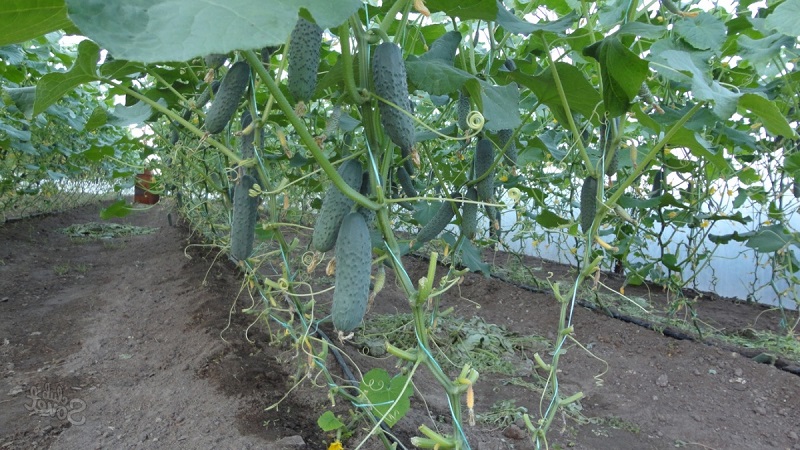
What cucumbers are suitable for growing in this climate
The cultivation of cucumbers in the Ural region is difficult due to the harsh climate. But there is a wide range of varieties that can withstand local weather conditions... Which cucumber seeds to choose for the Urals?
Characteristics of planting material for growing in the Urals:
- preference is given to early and mid-season varieties due to the short summer;
- variety or hybrid should be self-pollinated;
- frost resistance;
- strong immunity to disease.
It is not recommended to plant late varieties cucumbers. They will not have time to mature in the Urals.
The best self-pollinated cucumber hybrids for the greenhouses of the Urals
The choice of a variety directly depends on the part of the region... In the south, due to the fairly long summer, almost all varieties are suitable. And for the north of the Urals, ultra-early self-pollinated hybrids are chosen.
Early ripe
In the Ural climate cucumbers with a short growing season are of great value.
Voyage F1
Ripening period 35 days... Gherkin type cucumbers. Fruit size 90-110 g, has tubercles. The ovaries are bundled up. Average yield 12-14 kg / m2... The use is mainly salad. Resistant to powdery mildew and frost.
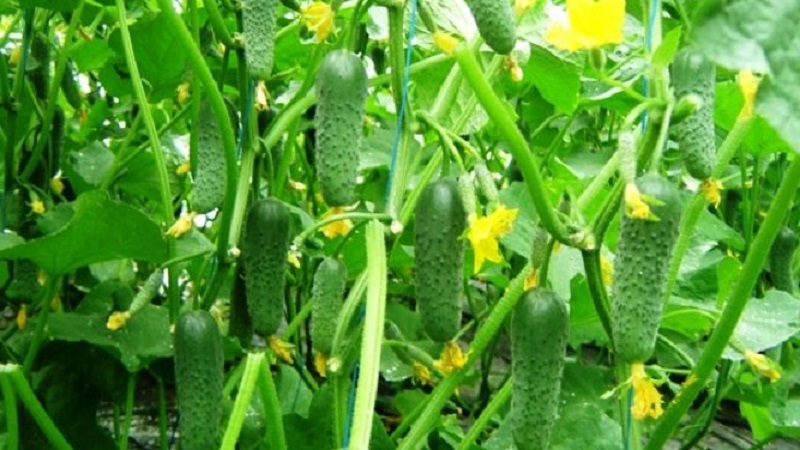
Emerald Family F1
Hybrid with an early ripening period - 40-45 days... Stable fruiting, but short-lived. The bush is high, the type of ovaries is bouquet, 5 ovaries are formed. The fruit is 10-12 cm in size with a dark skin. Mass 120-130 g. The flesh is crispy. Productivity 14-16 kg / m2... The use is universal. The hybrid is unpretentious, resistant to temperature changes. Not susceptible to olive spot, powdery mildew.
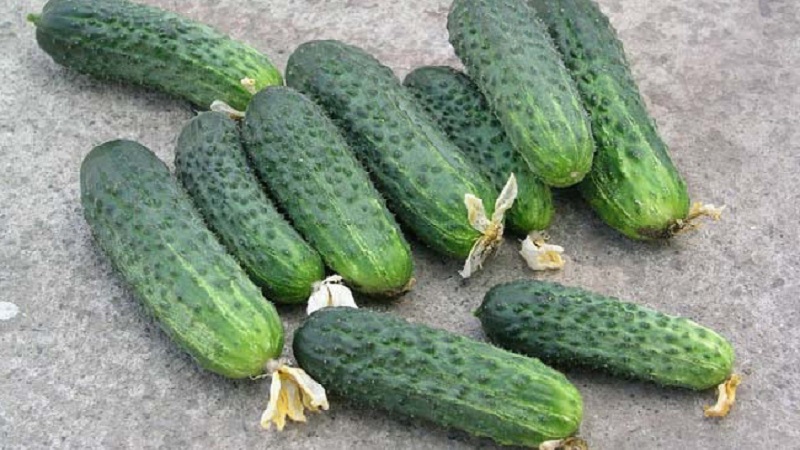
Herman F1
Early ripening - 38-40 days... Medium-sized bush. Oval cucumber weighing up to 100 g. It has a sweetish taste.Average yield 12-14 kg / m2... Application - mainly in salads. Hermann resistant to disease, but suffering from pests.
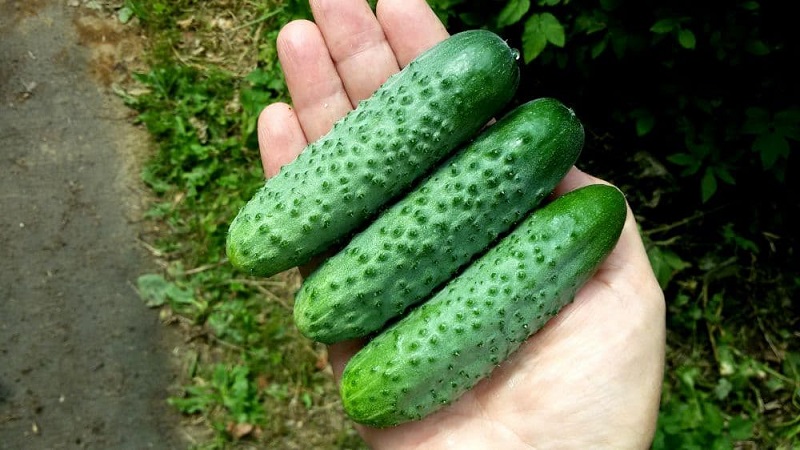
Courage F1
Ripening period 35-45 days... Medium-sized bush. Cucumber mass 120-140 g. Compared to other hybrids Courage has a low yield - 6-9 kg / m2... Long fruiting. Universal application of the fruit. Resistant to olive spot, mosaic, powdery mildew.
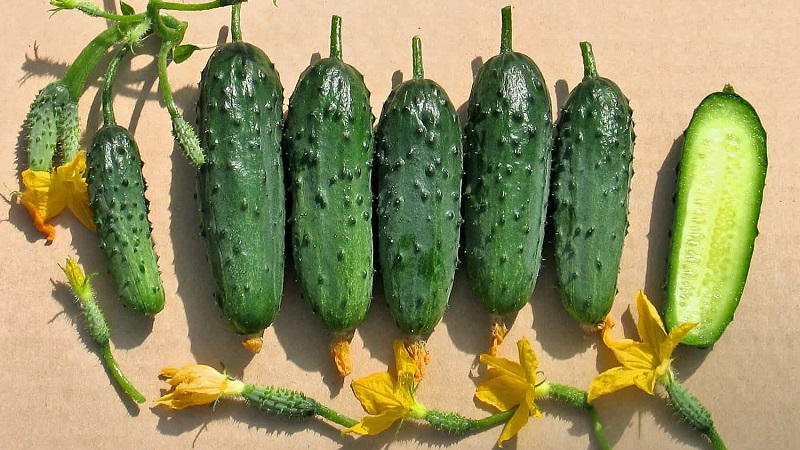
Cupid F1
Hybrid Amur Russian selection. Early ripening - 35-38 days... Cucumber is oval-elongated, up to 14 cm long, without bitterness. Weight 90-120 g. High yield - 25-28 kg / m2... It is resistant to cold and cucumber diseases. The application is universal.

Karelian F1
Ripening period 43-45 days... Short-fruited hybrid 8-10 cm long. Large tuberous. The fruiting period is extended. Average yield 14-16 kg / m2... The application is universal. Cold-resistant, unpretentious. Resistant to cucumber diseases.
Miranda F1
Hybrid of early ripening - 40-45 days... Bred by Russian breeders. Highly resistant to cold. Gherkin type cucumber, up to 11 cm long. Fruit weight 110-120 g. Productivity 5-6.3 kg / m2... The application is universal. Resistant to cucumber diseases.
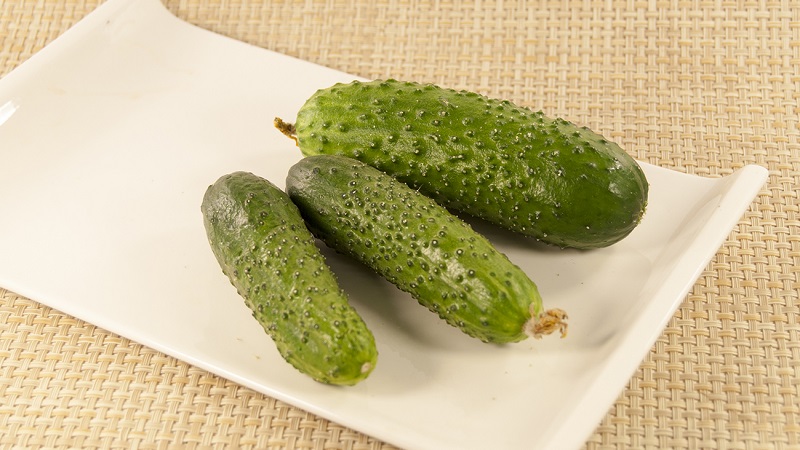
Altai F1
The seeds are highly germinating. Ripening period 43-45 days... The fruit is light green, grows up to 12 cm.Large tuberous, weighing up to 70 g. The yield reaches 6 kg / m2... Cold-resistant and unpretentious hybrid. Resistant to cucumber mosaic virus and powdery mildew. Often used in salting, it has good keeping quality.

Mid-season
In areas with a long summer period, mid-season hybrids can be grown.
Chinese disease resistant F1
Mid-early hybrid. Ripening period 48-53 days... The bush is tall, with short internodes. Cucumbers are dark green, large-lumpy, weighing up to 300 g. Length 30-35 cm. Productivity up to 30 kg / m2... The hybrid is cold-resistant, resistant to cucumber diseases. The application is universal.
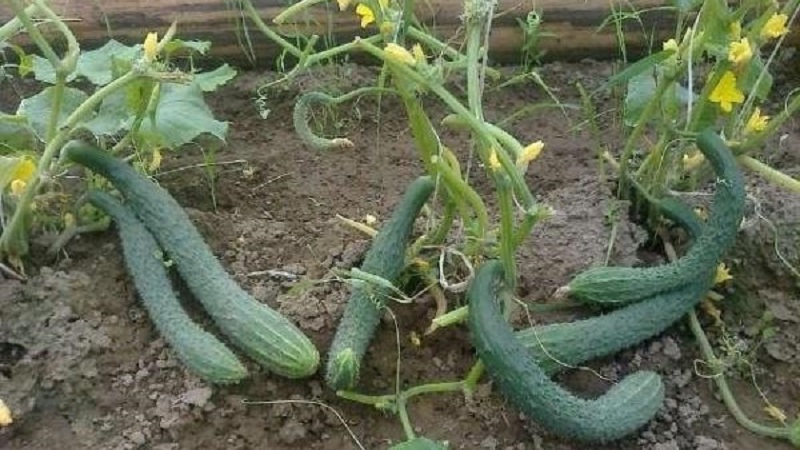
Marinda F1
Average ripening period 40-55 days... High yield Marinda F1 gives when grown in a greenhouse - 25-27 kg / m2... The fruit is oval in shape, with dense and juicy pulp, weighing 60-70 g. The hybrid is suitable for long storage, unpretentious, has a high germination capacity. Resistant to spotted mosaic, scab, olive spot, cladosporium.

Wear F1
Hybrid of Dutch selection. Ripening period 50-55 days... Suitable for growing in greenhouses and at home. Fruit size 7-10 cm, small tubercles on the skin. Average weight - 80-95 g. Medium-growing bush, many side shoots, 2-3 ovaries. Productivity 13-16 kg / m2... Used mainly for salting. It is resistant to cladosporia, cucumber mosaic, powdery mildew.
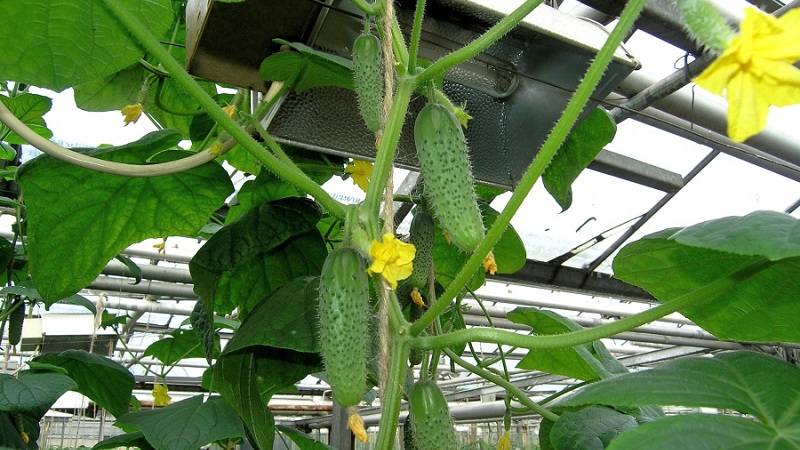
April F1
Ripening period 45-50 days... The fruit is cylindrical, 15-25 cm long. Weight 200-250 g. The limited lateral branching excludes the work of pinching and pinching. Productivity 18-22 kg / m2... Cold resistant. The April F1 is resistant to cucumber diseases. The application is universal.
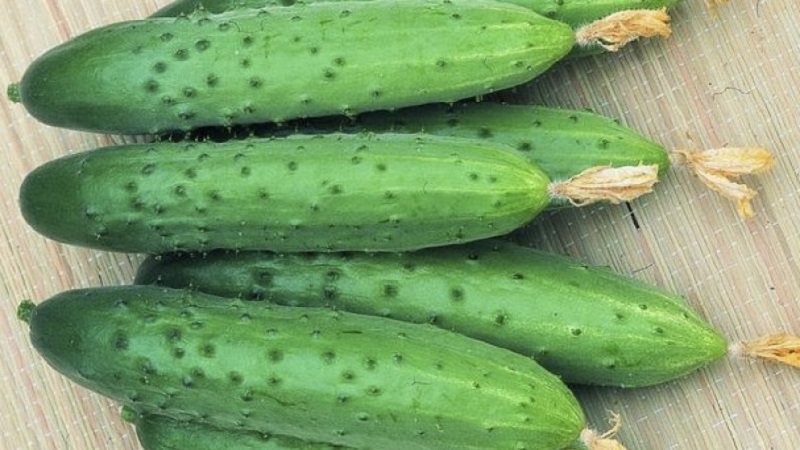
Garland F1
Ripening period 45-50 days. The bush is weakly branched, with vigorous growth. The fruit is light green in color, 12-14 cm long.Mass of a cucumber is 120-130 g. Average yield is 14-16 kg / m2... Hybrid Garland shade-tolerant and cold-resistant. The application is universal. Resistant to root rot, powdery mildew, olive spot, relatively resistant to downy mildew.
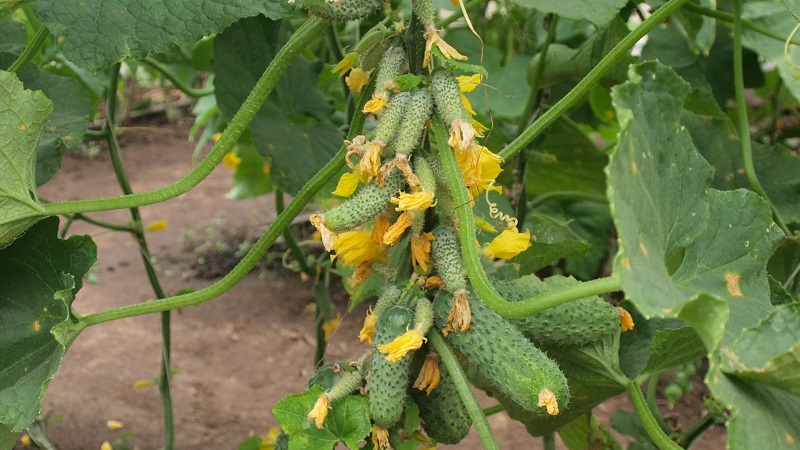
Mother-in-law F1
Ripening period 45-48 days. Medium-branched bush. Up to 3-4 ovaries are formed in the leaf axil. The fruit is cylindrical, 11-13 cm long, weighing 100-120 g. The yield reaches 12 kg / m2... The application is universal. Mother-in-law - cold-resistant hybrid.Possesses complex resistance to the main diseases of the cucumber.
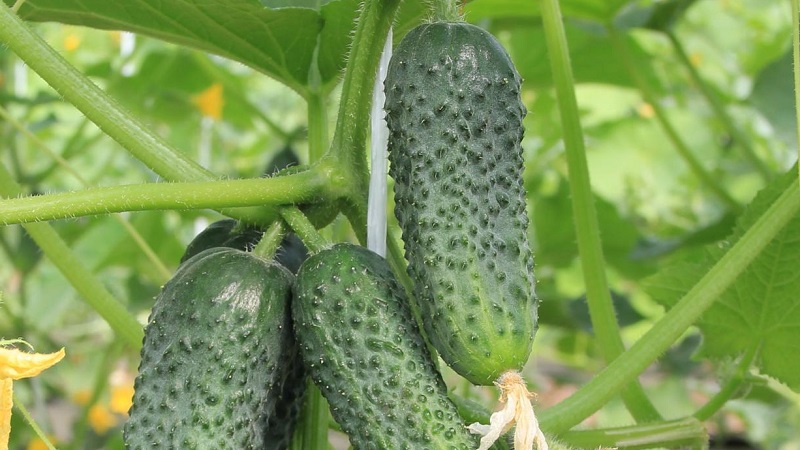
Features of growing and caring for cucumbers in the Urals
Cucumbers are grown in the Urals, usually indoors.... To get a harvest faster, it is recommended to plant seedlings in advance. The planting time of seedlings depends on the type of greenhouse. The denser the greenhouse cover, the earlier the planting dates.
Seedlings are planted without biofuel:
- in glass greenhouses - from May 5;
- in greenhouses covered with plastic - not earlier than May 20.
Using biofuels (organic fertilizer) - from the beginning of May to polyethylene greenhouses.
Important! Cucumbers do not tolerate the increased concentration of salts in the soil solution and do not like to overdo it in fertilizers.
Sowing stages of cucumbers:
- plant seeds in fertile loose soil and cover with soil 2 cm;
- pour abundantly and cover with foil, remove to a warm place;
- plant seedlings in the ground with the appearance of 3-4 true leaves;
- landing pattern - 70x30 cm.
Good predecessors for cucumber are cabbage, onions, tomatoes.
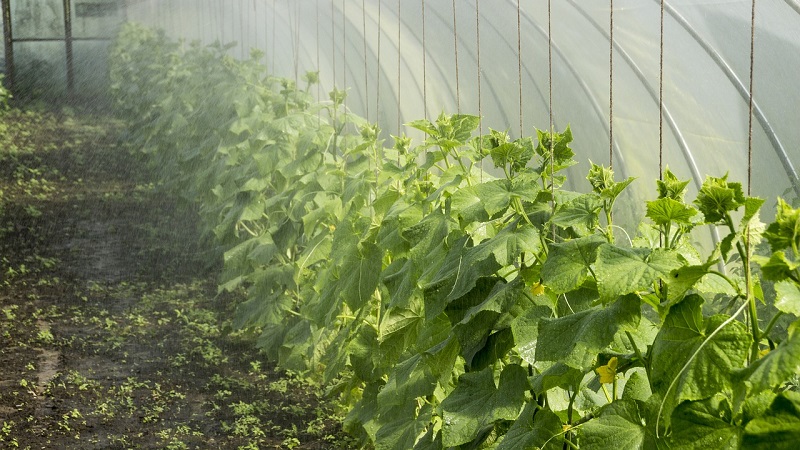
Rules for caring for cucumbers in the Urals:
- Timely watering.
- The first feeding is 3-4 days after transplanting. Prepare a solution of organic fertilizer 1:10 with the addition of 1 g / l of carbamide.
- Weeding and loosening.
- Second dressing during flowering. A solution is prepared from an organic fertilizer of 1 g / l of carbamide, 2 g / l of superphosphate and 2 g / l of potassium sulfate.
- Lime is added to maintain normal soil acidity.
- Preventive treatment against pests and diseases.
Cucumbers consume most of the nutrients during fruiting., at this time they are especially responsive to feeding.
Reviews of experienced gardeners
Ural gardeners advise not to dwell on only one hybrid cucumbers, and plant at least 4-5.
Oleg, Yekaterinburg: “I started to deal with cucumbers when I set up a good greenhouse. Unfortunately, in the conditions of the Urals, not all crops are available for cultivation. I plant hybrids Marinda F1 and Magnificent Five F1. Problems do arise, of course, but they are minor. Thanks to the greenhouse conditions, the cucumbers have time to ripen. Long-term fruiting, the taste is excellent ".
Lilia, Chelyabinsk: “In the Urals it is difficult to grow cucumbers, but if you follow certain rules, the plants will grow and bear fruit well. For planting, I always take hybrids Ant F1 and April F1. I grow through seedlings. I harvest the crop in several stages. With normal care, the harvest is enough even for sale ".
Conclusion
To grow cucumbers in the Urals, you should pay attention to the fruiting timing of the variety. It is better to give preference to self-pollinating hybrids. Be sure to follow the order of feeding and take care of the plants - this will allow you to get a high yield even in difficult climates.